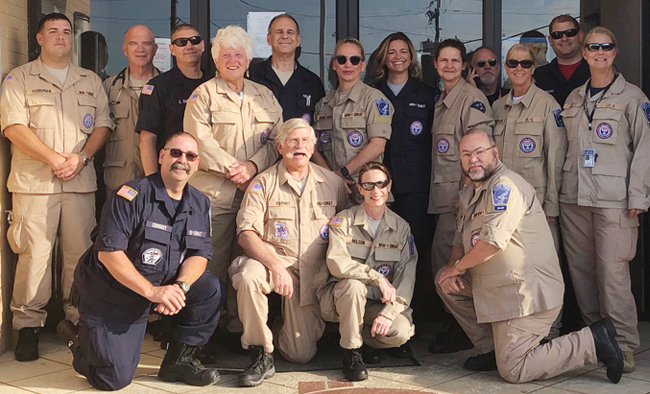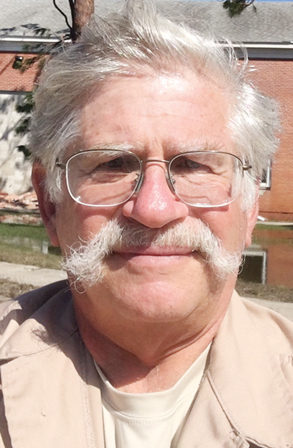
Dr. Allen Parmet has been putting on fatigues, sleeping in a cot — at best — and eating MREs just over 50 years. The first 25 of those years were spent serving his country in the Air Force. But because old soldiers, or in his case airmen, don’t fade away he has continued to serve by providing medical care throughout the country, and in some cases across the world, following natural disasters.
“I always felt we should be serving our people and our country,” said Dr. Parmet. “Since I have the training and experience from the military, I believe I should continue to use these skills and to serve our people.”
 His service began after he graduated from Shawnee Mission East High School in 1968, when he enrolled in the Air Force Academy. There he earned a bachelor’s degree in chemical engineering; He then earned a medical degree at the University of Kansas School of Medicine, a master’s in public health, and certification by the Board of Preventative Medicine, with subspecialties in occupational medicine and aerospace medicine — all while serving in the military. Since 1993 he has been a volunteer for disaster relief, using the skills he learned in the military.
His service began after he graduated from Shawnee Mission East High School in 1968, when he enrolled in the Air Force Academy. There he earned a bachelor’s degree in chemical engineering; He then earned a medical degree at the University of Kansas School of Medicine, a master’s in public health, and certification by the Board of Preventative Medicine, with subspecialties in occupational medicine and aerospace medicine — all while serving in the military. Since 1993 he has been a volunteer for disaster relief, using the skills he learned in the military.
“Going to medical school was my duty assignment,” he said. He ended his military career as an Air Force colonel.
As a military doctor he spent much of his time on preventative medicine. In fact he said even in places like Afghanistan and Iraq, docs often saw more problems relating from disease and accidents from the personnel they treated than from military action.
“The military has a much larger preventative medical program than in the civil world. Almost a quarter of medical resources in the military is devoted to prevention and public health,” he said.
Dr. Parmet did a fellowship in space medicine, which he earned at the Johnson Space Center, as well as completing residencies in aerospace medicine and occupational medicine and toxicology training. Later in his career he served as president of the American Association of Specialists in Aerospace Medicine. His specialization led him to work as the last medical director of Trans World Airlines. In addition he was a senior aviation medical examiner for the Federal Aviation Administration (FAA) and a consultant to the National Transportation Safety Board and NASA’s Aerospace Safety Board.
As a youth Dr. Parmet became a Bar Mitzvah at Kehilath Israel Synagogue in the 1960s. He and his wife, Debra, returned to Kansas City after he retired from the military. The couple belongs to the New Reform Temple. Their two grown sons live in Illinois and Colorado.
Simply being a physician in his occupational medicine practice in Kansas City, Missouri, doesn’t fulfill Dr. Parmet’s desire to serve others. He puts his military medical experiences to use as a volunteer medical officer — sometimes the chief medical officer — on missions for either the National Disaster Medical System (NDMS) or the Missouri Disaster Medical Assistance Team (DMAT).
During his 25 years of volunteering, which he started after retiring from active duty in 1993, Dr. Parmet has been deployed on medical missions more than 20 times. Each mission lasted no more than two weeks, but sometimes he rotated in and out over months-long service, as in Puerto Rico, when his team rotated in and out of the disaster sites for six months.
Their deployments are seen as comparable to a National Guard call up. Thus members of his team can take the two weeks to do their medical work in disaster areas. Since Dr. Parmet is in private practice, he leaves as needed to volunteer.
The people Dr. Parmet volunteers with are important to him.
“We are a team,” he said. “It is not about the individuals, but what we can do as a team. We take our skills and abilities and go out to help people.”
Each team is comprised of a physician, a nurse practitioner, three nurses, EMTS and a logistical person who gathers all the supplies. The deployment set up looks like a military MASH unit.
“In DMAT, we use the same equipment as the military, but it is not khaki,” he said. “Instead it is red, white and blue.”
These military transportable hospitals are more than just surgical units. They are attached to a transportable field hospital.
“We have all our equipment with us as we are self-supporting for the first 10 days,” he said. In fact, they can set up their field hospitals in less than 24 hours.
Dr. Parmet has been at disaster sites throughout the United States, from as close as Joplin, Missouri, in the aftermath of the deadly 2011 tornado; to hurricane sites where Katrina, Ike, Harvey, Florence and Michael came onshore. He has been to the U.S. Virgin Islands, Puerto Rico; and out of the country in Haiti and Japan.
In October, he was dispatched to Florida, where he ended up in Blountstown. The eye of the storm passed over Blountstown and “the hospital was a wreck.” His team set up an emergency room and went to work. Once the roads were cleared of debris, they started “house calls” to small communities, going to churches, fire stations and libraries to provide on-site medical care, vaccines, medications, food and water.
“It’s amazing how many ways you can hurt yourself with a chain saw,” he said, noting they were relieved by another unit of medical volunteers after two weeks.
He is proud of the work his medical mission teams do.
“We are Americans taking care of Americans and anyone else in need,” he said.
Dr. Parmet does see his volunteering days coming to a close.
“I am getting near the end,” he said. “I have been doing this for about 50 years. The physical demands and staying mentally sharp are getting more difficult. I am considering saying it is time to retire. Physically it is getting too hard to go on these demanding deployments.”


